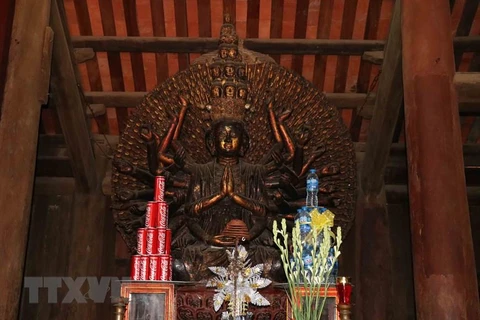Hanoi (VNA) – Visitors flocked to Phat Tich pagoda in Tien Du district, the northern province of Bac Ninh, for a local annual spring festival held on January 28 (the fourth day of the first lunar month).
Apart from rituals praying for peace, the festival featured an array of cultural and art activities, and folk games.
During the festival, Tien Du district has paid attention to ensuring security and safety for visitors, environmental protection, food hygiene and safety, and firefighting.
The Phat Tich pagoda, a special national relic site located just 25 kilometres northeast of Hanoi, was built in 1057 on a mountain called Lan Kha during the reign of King Ly Thanh Tong (1054-72). It was reduced to ashes by French colonialists in 1948 and restored in 1987.
During the excavation of the pagoda from 1949-51, archaeologists found numerous old stone sculptures carved with flowers and dragons, bird goddess statues from the 17th century, and a piece engraved with the head of a fairy, all of which are now on display at the National History Museum.
A giant Buddha Amitabha statue, 27 metres tall and weighing 3,000 tonnes, was installed outside on the Lan Kha Mountain in 2010. It was adapted from a similar structure from the Ly Dynasty.
The Phat Tich Pagoda is associated with Tu Thuc’s meeting with a fairy. As the legend goes, there were endless peonies on Lan Kha Mountain and in the pagoda, leading a young woman to visit the pagoda one day to see the flowers. She carelessly broke a tree branch and was fined by the monks, but a local scholar, Tu Thuc, was also visiting the pagoda and offered his coat to compensate for the broken branch. They became friends and continued to meet at the pagoda. The woman ultimately invited Tu Thuc to visit her house, leading him to a peony forest and into a cave on the mountainside with an imperial palace with high walls and stone footsteps. She revealed that she was a fairy and they got married.
Every year, people visit the pagoda to take part in the peony festival, where they enjoy looking at the flowers, listening to quan ho (love duets) and poem recitations, and playing traditional games. The festival usually lasts two days.
The pagoda was recognised as a national relic site in 1962 and a special national relic site in 2014./.
VNA























